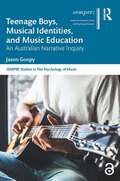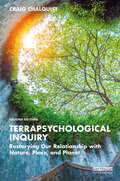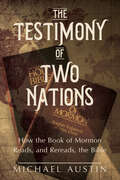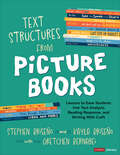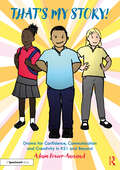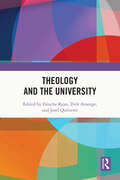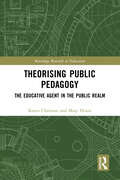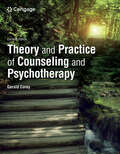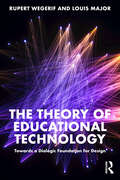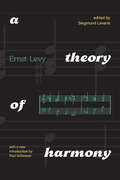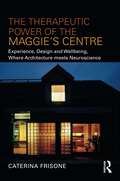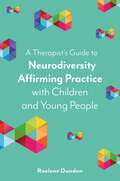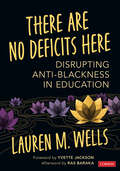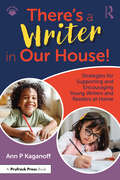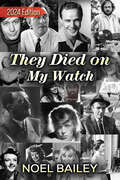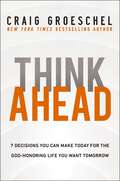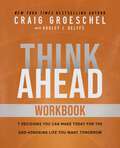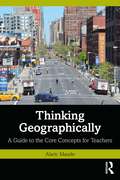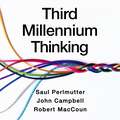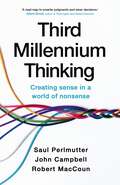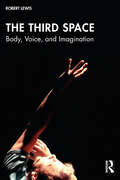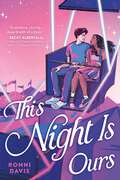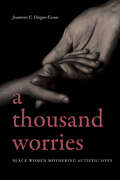- Table View
- List View
Teenage Boys, Musical Identities, and Music Education: An Australian Narrative Inquiry (ISSN)
by Jason GoopyMusic is a powerful process and resource that can shape and support who we are and wish to be. The interaction between musical identities and learning music highlights school music education’s potential contributions and responsibilities, especially in supporting young people’s mental health and well-being. Through the distinctive stories and drawings of Aaron, Blake, Conor, Elijah, Michael, and Tyler, this book reveals the musical identities of teenage boys in their final year of study at an Australian boys’ school.This text serves as an interface between music, education, and psychology using narrative inquiry. Previous research in music education often seeks to generalise boys, whereas this study recognises and celebrates the diverse individual voices of students where music plays a significant role in their lives. Adolescent boys’ musical identities are examined using the theories of identity work and possible selves, and their underlying music values and uses are considered important guiding principles and motivating goals in their identity construction. A teaching and learning framework to shape and support multiple musical identities in senior secondary class music is presented.The relatable and personal stories in this book will appeal to a broad readership, including music teachers, teacher educators, researchers, and readers interested in the role of music in our lives. Creative and arts-based research methods, including narrative inquiry and innovative draw and tell interviews, will be particularly relevant for research method courses and postgraduate research students.
Terrapsychological Inquiry: Restorying Our Relationship with Nature, Place, and Planet
by Craig ChalquistTerrapsychological Inquiry is a path of storied, imaginative research that takes seriously our intense inner responses to the state of the natural world. This place-rooted approach studies, from the standpoint of lived experience, how the world gets into the heart. Oceans and skies, trees and hills, rivers and soils, and even built things like houses, cities, ports, and planes: How do they show up for us inwardly? How do our moods, feelings, and dreams reflect what happens in the world? Terrapsychological Inquiry evolved over a decade of exploration by graduate students, instructors, ceremonialists, workshop leaders and presenters, and other practitioners of embodied creativity to offer an Earth-honoring mode of storied qualitative inquiry, one that transforms all involved from passive spectators of the doings of the world into active, sensitive participants. Learn how to use this methodology of earthly reenchantment in a variety of settings inside and outside academia and by doing so reenter an animate world. This new edition has been revised throughout and offers fresh insights into how Terrapsychological Inquiry, a field with roots in depth psychology, ecopsychology, and Hermetic philosophy, can also be used as an ecospiritual path. Thoroughly updated with a new chapter and added discussion questions and exercises at the end of each chapter, this introduction to an evolving research methodology will be of great interest to students and scholars of environmental psychology, ecotherapy, and environment and sustainability studies more generally.
The Testimony of Two Nations: How the Book of Mormon Reads, and Rereads, the Bible
by Michael AustinUnderstanding the Book of Mormon on its own terms and through its two-way connection with the Bible Like the Hebrew Bible and the Christian Bible, the Book of Mormon uses narratives to develop ideas and present instruction. Michael Austin reveals how the Book of Mormon connects itself to narratives in the Christian Bible with many of the same tools that the New Testament used to connect itself to the Hebrew Bible to create the Christian Bible. As Austin shows, the canonical context for interpreting the Book of Mormon includes the Christian Bible, the Book of Mormon itself, and other writings and revelations that hold scriptural status in most Restoration denominations. Austin pays particular attention to how the Book of Mormon connects itself to the Christian Bible both to form a new canon and to use the canonical relationship to reframe and reinterpret biblical narratives. This canonical context provides an important and fruitful method for interpreting the Book of Mormon.
Text Structures From Picture Books [Grades 2-8]: Lessons to Ease Students Into Text Analysis, Reading Response, and Writing With Craft (Corwin Literacy)
by Stephen Briseño Kayla Briseño Gretchen BernabeiTeach students the architecture beneath a successful story—and boost their reading comprehension and writing skills for a lifetime Writing instruction can sometimes seem scattershot, as teachers try to cover a galaxy of craft techniques, ideas, intentions, and genres. The possibilities are endless—and that’s the problem. In Text Structures from Picture Books, elementary and middle grade teachers tap into a well-ordered universe of inspiring and illustrative stories to help students frame their thinking and focus choices. Using the bite-size format of picture books as a starting point, the authors share 50 low-prep, quick-access lessons to help you teach students seven concrete ways to respond to text in any genre. Through these lessons, students will be able to: Generate their own writing, using a text structure harvested from the work of professional authors Retell a story, using the text structure from the story Generate reading responses, using structures that support clarity Analyze a story to construct thematic statements, capturing the author’s message and bigger themes Write about a theme or big idea demonstrating empathic and evidence-based interpretation Answer open-ended questions by selecting a technique that reflects the text and their engagement Experiment with author’s craft in their own writing Based on master writing teacher Gretchen Bernabei’s instructional model, the lessons offer a lively, high-impact mix of reading aloud, discussion, modeling, student writing, and peer share. Plus, readers have access to a complete companion website full of text structure reproducibles, reading response prompts, additional lessons and extensions, students samples, and links to demo videos. State tests are now assessing reading and writing together. And that’s a good thing—but we’ve got some catching up to do. Written for students beginning in second grade, Text Structures from Picture Books will help your students swiftly and surely become text-savvy readers and writers.
Text Structures From Picture Books [Grades 2-8]: Lessons to Ease Students Into Text Analysis, Reading Response, and Writing With Craft (Corwin Literacy)
by Stephen Briseño Kayla Briseño Gretchen BernabeiTeach students the architecture beneath a successful story—and boost their reading comprehension and writing skills for a lifetime Writing instruction can sometimes seem scattershot, as teachers try to cover a galaxy of craft techniques, ideas, intentions, and genres. The possibilities are endless—and that’s the problem. In Text Structures from Picture Books, elementary and middle grade teachers tap into a well-ordered universe of inspiring and illustrative stories to help students frame their thinking and focus choices. Using the bite-size format of picture books as a starting point, the authors share 50 low-prep, quick-access lessons to help you teach students seven concrete ways to respond to text in any genre. Through these lessons, students will be able to: Generate their own writing, using a text structure harvested from the work of professional authors Retell a story, using the text structure from the story Generate reading responses, using structures that support clarity Analyze a story to construct thematic statements, capturing the author’s message and bigger themes Write about a theme or big idea demonstrating empathic and evidence-based interpretation Answer open-ended questions by selecting a technique that reflects the text and their engagement Experiment with author’s craft in their own writing Based on master writing teacher Gretchen Bernabei’s instructional model, the lessons offer a lively, high-impact mix of reading aloud, discussion, modeling, student writing, and peer share. Plus, readers have access to a complete companion website full of text structure reproducibles, reading response prompts, additional lessons and extensions, students samples, and links to demo videos. State tests are now assessing reading and writing together. And that’s a good thing—but we’ve got some catching up to do. Written for students beginning in second grade, Text Structures from Picture Books will help your students swiftly and surely become text-savvy readers and writers.
That's My Story!: Drama for Confidence, Communication and Creativity in KS1 and Beyond
by Adam Power-AnnandThe ability to communicate is an essential life skill for all children and young people and it underpins their social, emotional and educational development. If a child experiences a positive relationship with an adult listening carefully, they are more likely to constructively share their thoughts, feelings and their imaginative ideas.That’s My Story! places children’s imagined stories at the heart of their own development and provides a joyful, creative approach to support young children’s personal and social development and to encourage their communication. In this book you will find: Tried-and-tested drama games and activities that support communication and well-being, all adaptable to complement your current practice Guidance and advice on how to promote positive adult-child interactions Examples of creative interventions that support children’s communication development A celebration of the joy that comes with carefully listening to children’s own imagined stories Those of us who work with children can sense a tangible connection between how young children feel and how they communicate. This essential and practical resource will be valuable reading for primary teachers, teaching assistants, speech and language therapists, and drama practitioners, as well as outreach and education departments of theatre companies and other arts organisations.
Theology and the University
by Fáinche Ryan Dirk Ansorge Josef QuittererTheology and the University presents a compelling argument as to why theology still matters. It considers how theology has been marginalised in the academy and in public life, arguing that doing so has serious repercussions for the integrity of the academic study of religion.The chapters in this book demonstrate how theology, as the only discipline which represents religion from within, provides insight into aspects of religion which are hidden from the social sciences. Against a backdrop of heated debates on the role of the humanities in the university, the book highlights the specific contribution of theological education and research to the work of a university, providing essential information for academic and social/political decision-making. Whilst the book has an emphasis on the Catholic tradition, it explores the prospect of fruitful complementarity and interdisciplinarity both with secularised studies of religion, and other disciplines in the university, such as literature, philosophy, and the social sciences.This book provides orientation for decision-makers, particularly those concerned with the broader question of humanities in the university; students in their choice of study; those interested in the wellbeing of today’s universities; and ecclesial authorities seeking to form leaders capable of intelligent responses to the issues of contemporary society. It is a must read for all researchers of theology, as well as anyone interested in the role of the humanities more broadly.
Theorising Public Pedagogy: The Educative Agent in the Public Realm (Routledge Research in Education)
by Karen Charman Mary DixonDrawing on the ideas of Hannah Arendt and Michel Foucault, this book extends the theoretical understanding of public pedagogy and brings into sharp focus the elements that constitute the public realm; the site of public pedagogy. Karen Charman and Mary Dixon offer a new theorisation of the public, a term at the heart of debate in the field, heightened in this post-truth era by the COVID-19 pandemic, the rise of fake news and the technological reconfigurations of public life. The new theorization addresses the ‘public’, ‘pedagogy’ and their confluence in ‘public pedagogy’. The book explores a deep engagement with the architecture and dynamics of pedagogy and argues for the positioning of pedagogy with the public. The authors contribute to a theorisation that re-considers the individual and their capacity for agency within the public realm. The book presents knowledge and pedagogical encounters as key elements of public pedagogy and most significantly, the educative agent as a means of critically rethinking social life and learning in public spaces. Presenting an innovative theoretical approach, this book will be of interest to academics in the fields of public and critical pedagogy and postgraduate students in education, cultural studies and politics.
Theory and Practice of Counseling and Psychotherapy
by Gerald CoreyIncorporating the thinking, feeling and behaving dimensions of human experience, the Eleventh Edition of Corey's best-selling text offers an easy-to-understand guide to help you compare and contrast the therapeutic models expressed in counseling theories. This wide-ranging text provides a thorough introduction to major theories including psychoanalytic, Adlerian, existential, person-centered, Gestalt, reality, behavior, cognitive-behavior, family systems, feminist, postmodern and integrative approaches. <p><p>With his trademark style, the author also demonstrates how each theory can be applied to two cases (""Stan"" and “Gwen”), providing valuable practical insights and helping you learn to integrate the theories into an individualized counseling style. In addition, the text features engaging media resources, available through MindTap, such as case-focused videos to help bring the material vividly to life.
The Theory of Educational Technology: Towards a Dialogic Foundation for Design
by Rupert Wegerif Louis MajorEducational technology is controversial – some see it as essential to providing free global learning, others view it as a dangerous distraction that undermines good education. In both instances, most theories that have previously been applied to educational technology do not account for the distinctive nature and vast potential of technology. This book addresses this issue, exploring how education has been bound up with technology from the beginning, and recognising that educational aims have already been shaped by technologies. Offering a ‘dialogic’ theory of educational technology, Rupert Wegerif and Louis Major respond to contemporary challenges to education within this book, including, but not limited to, climate change, misinformation on the internet and the impact of Artificial Intelligence. Chapters introduce, discuss, and contextualise key theories and illustrate through case studies their uses within a diverse range of educational contexts, spanning from primary education to adult lifelong learning. Each chapter also concludes with a short summary, demonstrating how these theories translate to practical implications for design. A fascinating response to current developments in educational technology, this is a crucial read for all involved in creating, researching or making decisions about the use of technologies within educational contexts.
A Theory of Harmony: With A New Introduction by Paul Wilkinson
by Ernst LevyErnst Levy was a visionary Swiss pianist, composer, and teacher who developed an approach to music theory that has come to be known as "negative harmony." Levy's theories have had a wide influence, from young British performer/composer Jacob Collier to jazz musicians like Steve Coleman. His posthumous text, A Theory of Harmony, summarizes his innovative ideas. A Theory of Harmony is a highly original explanation of the harmonic language of the modern era, illuminating the approaches of diverse styles of music. By breaking through age-old conceptions, Levy was able to reorient the way we experience musical harmony.British composer/music pedagogue Paul Wilkinson has written a new introduction that offers multiple points of entry to Levy’s work to make this text more accessible for a new generation of students, performers, and theorists. He relates Levy's work to innovations in improvisation, jazz, twentieth-century classical music, and the theoretical writings of a wide range of musical mavericks, including Harry Partch, Hugo Riemann, and David Lewin. Wilkinson shows how A Theory of Harmony continues to inspire original musical expression across multiple musical genres.
The Therapeutic Power of the Maggie’s Centre: Experience, Design and Wellbeing, Where Architecture meets Neuroscience
by Caterina FrisoneThis book is about the therapeutic environment of the Maggie’s centre and explores the many ways this is achieved. With an unconventional architecture as required by the design brief, combined with Maggie’s psychological support programme, this special health facility allows extraordinary therapeutic effects in people, to the point that one can speak of therapeutic power.After tracing the story of the Maggie’s centre, the book reveals its fundamentals: Maggie’s Therapeutikos (the-mind-as-important-as-the-body), the Architectural Brief and the ‘Client-Architect-Users’ Triad. It continues by unfolding Maggie’s synergy-that between people and place-which increases users’ psychological flexibility helping them tolerate what was intolerable before. Although comfort and atmospheres are paramount, they are not enough to define the therapeutic environment of the Maggie’s centre. Only by looking at neuroscience that can give us scientific explanations of empathy, feelings and emotions and only considering space neither neutral nor empty, but full of forces that envelop people in an embodied experience, can we explain what generates wellbeing in a Maggie’s centre.The book concludes by critically evaluating the Maggie’s centre as a model to be applied to other healthcare facilities and to architecture in general. It is essential reading for any student or professional working on therapeutic environments.
A Therapist’s Guide to Neurodiversity Affirming Practice with Children and Young People
by Raelene DundonIn this honest and practical guide, autistic therapist Raelene Dundon explores and demystifies how neurodiversity affirming principles can be easily applied to therapeutic practice.Covering essential considerations for working with neurodivergent clients such as presuming competence, promoting autonomy and respecting communication styles, and providing advice on the best affirming approaches in therapy including how to accommodate sensory needs and encourage self-advocacy, Raelene provides easy-to-implement ways to make your practice inclusive and empowering for neurodivergent children and young people.The deficit model is out. It's time to become neurodiversity affirming.
There Are No Deficits Here: Disrupting Anti-Blackness in Education
by Lauren M. WellsDisrupt the deficit beliefs that steal belonging, purpose, pride, and joy from Black students School reform efforts have long dominated the educational landscape, but the fixes that characterize many school improvement initiatives swing on the hinges of deficit beliefs about Black students. This book calls for a disruption in these models and urges educators to take seriously the significance of beliefs and cultures within schools. Focused on racial equity from an ecological perspective and designed to propel readers to examine individual and systemic beliefs operating in their ecosystems, this book provides Details on emancipatory educational ecosystems governed by beliefs that affirm Black children and immerse them in learning where their identities matter A set of beliefs that work together to create collective mindsets needed to power change A counternarrative of how interrelationships and interdependence govern healthy systems by challenging the meritocracy, competition, and individualism. Grounded in extensive research and personal experience showcasing large-scale change efforts in major urban areas, Wells’ approach toward emancipatory educational ecosystems enables affirming beliefs to guide the work.
There Are No Deficits Here: Disrupting Anti-Blackness in Education
by Lauren M. WellsDisrupt the deficit beliefs that steal belonging, purpose, pride, and joy from Black students School reform efforts have long dominated the educational landscape, but the fixes that characterize many school improvement initiatives swing on the hinges of deficit beliefs about Black students. This book calls for a disruption in these models and urges educators to take seriously the significance of beliefs and cultures within schools. Focused on racial equity from an ecological perspective and designed to propel readers to examine individual and systemic beliefs operating in their ecosystems, this book provides Details on emancipatory educational ecosystems governed by beliefs that affirm Black children and immerse them in learning where their identities matter A set of beliefs that work together to create collective mindsets needed to power change A counternarrative of how interrelationships and interdependence govern healthy systems by challenging the meritocracy, competition, and individualism. Grounded in extensive research and personal experience showcasing large-scale change efforts in major urban areas, Wells’ approach toward emancipatory educational ecosystems enables affirming beliefs to guide the work.
There's a Writer in Our House! Strategies for Supporting and Encouraging Young Writers and Readers at Home
by Ann P. KaganoffThere’s a Writer in Our House! is an invitation to parents of children in first grade through fifth grade interested in actively participating in their children’s early literacy learning from the very first steps.Founded upon well-researched literacy instructional methods that have been informed by the author’s clinical perspective as well as her years of experience with many kinds of learners, this book provides a valuable understanding of how both writing and reading contribute to child development in multiple areas. Chapters provide background concepts regarding grammar and specific critical thinking skills in both writing and reading as well as customizable, child-centered activities used to practice and build writing and reading comprehension skills.You will learn how to advance and encourage your child’s learning and communication skills by highlighting important literacy areas such as vocabulary development, background knowledge, and critical thinking. You will also learn to recognize and track the significant developmental achievements of your child as you proceed from the early to the more complex At-Home activities, as well as receive strategies for how to respond and give feedback in specific situations, such as when a child writes something that makes sense to the child but not to the parent, how to offer feedback that identifies and labels a child’s strengths, and how to collaborate effectively with a child who is just developing new interests or a new willingness to try something that previously seemed “hard.”Practical, accessible, and most importantly, fun, this book is a must-read for all parents, regardless of background, seeking to support their children’s ongoing literacy development confidently and effectively.
They Died on My Watch: 2024 Edition
by Noel BaileyWho was the actress who died just before Christmas? She was the voice of …..... in …......Did Hitler commit suicide, or was he shot by Russian troops?Do you remember what year Princess Diana died in that car crash in Paris?How many husbands did Elizabeth Taylor divorce in her lifetime?What was that well known British actor who passed away right after David Bowie died?Questions you might hear at the next table of your favourite eatery. Questions you may or may not know the answer to. They Died on My Watch can answer these and many more. It is a comprehensive reference work that should prove itself indispensable to any household. Most certainly a book to sustain interest when cruising at 35,000 feet between London and New York. It might be seen as the ultimate &‘umpire&’ to settle any argument that may arise within a discussion involving a deceased celebrity, recent or not.
Think Ahead: 7 Decisions You Can Make Today for the God-Honoring Life You Want Tomorrow
by Craig GroeschelWhy do we keep making choices we later regret--sometimes even the same bad choices over and over? Drawing on Scripture, story, and cutting-edge research into human behavior, pastor Craig Groeschel reveals the key to making the choices we want to make and experiencing the joy and freedom God has for us.We all want to make great decisions. So what happens between our good intentions and the choices we actually make in the moment? If only we could make decisions ahead of time rather than when we're under stress, overwhelmed, or swayed by fear or emotion. In Think Ahead, we learn how to do just that.Pastor Craig Groeschel knows from personal experience and as a counselor to others what being trapped in a cycle of poor decision-making is like. In Think Ahead, he shares what he has discovered about the power of "pre-deciding."With thought-provoking exercises and questions for reflection, this interactive book teaches us that the quality of our decisions determines the quality of our lives. Think Ahead will help you:Understand the science behind your decision-making habitsOvercome decision fatigue and debilitating fearsDiminish the role of emotions in decision-makingSee how your small choices shape the kind of person you becomeDefine and put into action the seven life-defining pre-decisions you can make today Becoming the person you want to be starts before you even make a decision. In Think Ahead, you'll discover the power of making decisions today to help you live the life you want to have tomorrow.
Think Ahead Workbook: The Power of Pre-Deciding for a Better Life
by Craig GroeschelWe all want to make great decisions, but frequently, we don&’t. When the moment of truth arrives, we make choices that we later regret. It causes us to wonder if we actually can begin to make better decisions for our lives.Pastor and bestselling author Craig Groeschel understands this dilemma that we all face. From both personal experience and as a minister and counselor to others, he knows what it is like to be trapped in a cycle of bad decision-making. But over time, he has discovered how to short-circuit the bad-decision cycle, make wise decisions, and begin to become the person God wants us to be.In the Think Ahead Workbook, which accompanies the book of the same name, Craig draws on the truth of Scripture and the latest research in human behavior to reveal the power of making decisions in advance—what we might call &“pre-deciding&”—to position ourselves to make the choices we really want to make and avoid those choices that we do not want to make. In the process, he reveals:The science behind many of our decision-making habitsHow our small choices shape the kind of people we becomePractical steps we can employ to combat decision fatigueHow to develop the ability to diminish the role of emotions in decision-makingAre you ready to choose who you will become and live the life you really want to live? If so, this workbook will provide you with a clear biblical path on how to get there and think ahead.
Thinking Geographically: A Guide to the Core Concepts for Teachers
by Alaric MaudeThis book explains how the concepts of geography can teach young people to think geographically, deeply and ethically. Thinking Geographically demonstrates how the concepts of place, space, environment and interconnection teach students new ways of perceiving and understanding the world, the concepts of scale and time teach them ways of analysing the world, while the concepts of sustainability and wellbeing show them how to evaluate and reflect on what they observe, and all eight concepts develop their higher order and critical thinking. To further support teachers, this book includes a chapter on how to teach for conceptual understanding, as well as two chapters that illustrate the application of geographical thinking to an understanding of the effects of land cover change and the problem of regional inequality. Rich with practical examples, this book is an essential resource for geography teachers, whether already teaching or studying to become one, and for those who teach therm.
Third Millennium Thinking: Creating Sense in a World of Nonsense
by Saul Perlmutter Robert MacCoun John Campbell*Available for pre-order: a definitive guide to thinking clearly in a world full of overwhelming information*__________A Nobel prize-winning physicist, a social psychologist and a philosopher on how science can help us navigate information overload, thrive amidst uncertainty and heal our fractured society.In our deluge of information, it's getting harder and harder to distinguish the revelatory from the contradictory. How do we make health decisions in the face of conflicting medical advice? How can we navigate the next uncomfortable discussion with family members, who follow completely different experts on climate?In Third Millennium Thinking, a physicist, a psychologist, and a philosopher introduce readers to the tools and frameworks that scientists use to keep from fooling themselves, to understand the world, and to make decisions. We can all borrow from these trust-building techniques that scientists have tested and developed for more than two millennia to tackle problems both big and small.Listeners will learn:- How to gain a solid understanding of the facts that shape our modern world- How to navigate through a multitude of possibilities and make informed choices- How to collaborate effectively in tackling the challenges we encounter today- And much moreThrough engaging thought exercises, clear language free from technical jargon, and compelling illustrations drawn from history, everyday life, and insider stories of scientists, Third Millennium Thinking presents a fresh approach for readers to untangle the confusing and make sense of it all.__________'A model of clear thinking, and a terrific discussion of how to use logic and evidence to solve the hardest problems. This might just be the cure for what ails us.' Cass R. Sunstein, Robert Walmsley University Professor, Harvard University, and author of Decisions About Decisions
Third Millennium Thinking: Creating Sense in a World of Nonsense
by Saul Perlmutter Robert MacCoun John Campbell*Available for pre-order: a definitive guide to thinking clearly in a world full of overwhelming information*__________In our deluge of information, it's getting harder and harder to distinguish the revelatory from the contradictory. How do we make health decisions in the face of conflicting medical advice? How can we navigate the next uncomfortable discussion with family members, who follow completely different experts on climate?In Third Millennium Thinking, a physicist, a psychologist, and a philosopher introduce readers to the tools and frameworks that scientists use to keep from fooling themselves, to understand the world, and to make decisions. We can all borrow from these trust-building techniques that scientists have tested and developed for more than two millennia to tackle problems both big and small.Readers will learn:- How to gain a solid understanding of the facts that shape our modern world- How to navigate through a multitude of possibilities and make informed choices- How to collaborate effectively in tackling the challenges we encounter today- And much moreThrough engaging thought exercises, clear language free from technical jargon, and compelling illustrations drawn from history, everyday life, and insider stories of scientists, Third Millennium Thinking presents a fresh approach for readers to untangle the confusing and make sense of it all.__________'A model of clear thinking, and a terrific discussion of how to use logic and evidence to solve the hardest problems. This might just be the cure for what ails us.' Cass R. Sunstein, Robert Walmsley University Professor, Harvard University, and author of Decisions About Decisions
The Third Space: Body, Voice, and Imagination
by Robert LewisThe Third Space serves a crucial need for contemporary performers by providing an interdisciplinary and physiovocal approach to training. It is a new take on body and voice integration designed to develop the holistic performer. It takes performers through a series of step-by-step practical physiovocal exercises that connects the actor’s centre to the outside world, which increases awareness of self and space. It also develops a deeper connection between spaces within the body and the environment by connecting sound, imagination, and movement.Robert Lewis’s approach is a way of working that unlocks the imagination as well as connecting performers to self, space, and imagination, through voice and body. It conditions, controls, and engages performers by integrating various voice and movement practices.The theories and practice are balanced throughout by: introducing the practical works theoretical underpinnings through research, related work, and case studies of performances; demonstrating a full program of exercises that helps performers get in touch with their centre, their space, and shape both within and outside the body; and exploring the performers physiovocal instrument and its connection with imagination, energies, and dynamics. This book is the result of nearly 20 years of research and practice working with voice and movement practitioners across the globe to develop training that produces performers that are physiovocally ready to work in theatre, screen, and emergent technologies.
This Night Is Ours
by Ronni Davis&“Ronni Davis perfectly captures the terrifying joy of shaking off others&’ expectations and coloring in your own future—a sensitive, stirring, deep breath of a book.&” —Becky Albertalli, #1 New York Times bestselling authorFor one teen girl, the summer before college brings uncertainty about the future and a budding romance—perfect for fans of Nicola Yoon! It&’s the longest day of the year, and eighteen-year-old Brandy Bailey has just received the worst news of her life: She&’s been accepted to a top nursing school, making her mother overwhelmingly proud. The thing is, Brandy wants to be an artist. She knows all the risks of chasing her dream. She&’s heard them from her mother time and time again. Plus, Brandy&’s annoying classmate from high school, the annoyingly handsome Ben Nolan, is catching his far-fetched dream of being an actor. Why does he get to be fearless while she has to be practical? Ben is the last thing Brandy wants on her mind, so of course today is the day he decides to glue himself to her hip. Now his perfect face is right there in the cacophony crashing through her head. Swirling in too many directions, Brandy&’s emotions clash with the flashing lights at the town&’s summer carnival. Can she have one extraordinary night before everything changes? Ronni Davis spins a whirlwind summer romance full of cotton candy, funnel cake, and the sweetness of first love. Don't miss:When the Stars Lead to You
A Thousand Worries: Black Women Mothering Autistic Sons (SUNY series in Black Women's Wellness)
by Jeannine E. Dingus-EasonAutism is rising across the United States but disproportionately affects Black children and their families. While White middle-class families tend to be the focus of autism research and services, A Thousand Worries tells the stories of fifteen Black mothers of autistic sons, including the author’s own story. Interweaving her personal experience and research findings, Jeannine E. Dingus-Eason examines the intersections of race, class, and gender and the complexities of parenting, care, and services for Black autism mothers, or BAMs. Dingus-Eason shows how BAMs leverage their faith, support networks, and knowledge of autism to advocate for their sons in cultural and sociopolitical contexts that consistently dehumanize, criminalize, and adultify Black boys. A Thousand Worries will give families, scholars, and practitioners in education, social work, human services, and health insight into not only BAMs' many concerns and challenges but also their strengths, strategies, and abiding love. At times moving, uplifting, funny, and raw, their testimonies illuminate the power dynamics between parents and providers, the value of supportive partnerships and mutual trust, and the need for culturally responsive services.
